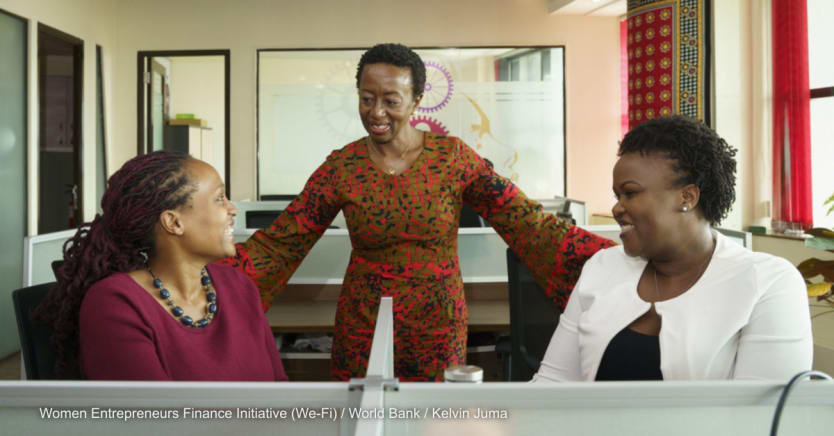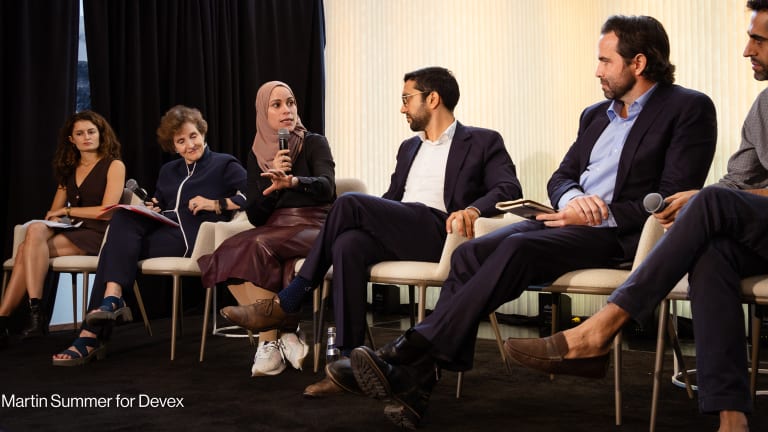
There are around 400 million female entrepreneurs worldwide, but major barriers to financial access persist, preventing huge economic benefits from being unlocked. Achieving gender parity in entrepreneurship could add $5 trillion to 6 trillion in net value to the global economy, according to the Women Entrepreneurs Finance Initiative, or We-Fi, a global partnership housed in the World Bank.
These hurdles have a big impact in low- and middle-income countries, where a higher proportion of women are entrepreneurs. “There’s not enough funding going out of the door to support women’s businesses, and make sure that they can grow and thrive,” said Wendy Teleki, head of the We-Fi secretariat.
This led We-Fi to launch the Women Entrepreneurs Finance Code, or WE Finance Code, in November 2023, bringing together financial service providers, regulators, development banks, and other players within countries to increase funding to female entrepreneurs. The initiative is supported by funders such as the Gates Foundation and Visa Foundation and received endorsements from heads of six multilateral development banks.
“We see the financial industry as needing to be much more intentional in thinking about what kinds of products and services can best address women’s needs,” Teleki said. Speaking to Devex, she talked about the challenges for female entrepreneurship in low- and middle-income countries, the progress of the WE Finance Code over the past year, and what it means for the future.
This conversation has been edited for length and clarity.
How do you see the current state of female entrepreneurship in LMICs?
The 400 million women entrepreneurs worldwide face a $1.7 trillion financing gap. There are also more in lower-income than higher-income countries, partly out of necessity because they may lack access to high-quality formal jobs or jobs that have the flexibility they need, or social norms such as childcare constraints might prevent them from working full time.
Women tend to operate smaller businesses in lower-margin industries and have access to fewer business networks and connections. Female entrepreneurs also have a harder time getting access to finance.
More analysis is needed to understand the business case for women entrepreneurs, as financial institutions that focus on them often find that women are valuable customers — tending to present both lower risk and greater loyalty than men. Women entrepreneurs are also more likely to hire and create jobs for other women, helping to meet an essential development challenge.
How did the WE Finance Code, which was launched by We-Fi just over a year ago, help to address these issues — and what are its main aims?
There have been various efforts by ourselves and others to address this situation. However, many financial institutions may not understand the women entrepreneurs segment or have the right data to address the financing gap it faces. With the WE Finance Code, we wanted to create a much stronger focus, making sure everything gets pulled together in a systematic way.

Concerning this, the Code has three main pillars. One is on leadership, involving identifying and engaging leaders in financial institutions to be advocates and champions for accelerating finance to women entrepreneurs. The second is focused on systematizing the collection, analysis, and use of data to help financial institutions, policymakers, and regulators target funding at women-led enterprises. The third is about action, to spur innovation, new financial product development, and training programs for women.
What kind of traction has the WE Finance Code gained over the past year?
When we originally came up with the concept, we thought we would have eight to 10 pilot countries at the start. However, by now we have 28 countries where National Codes would be piloted by our implementing partners — from Albania, Côte d’Ivoire, and the Dominican Republic to Fiji, Indonesia, and Madagascar. So far, over half of these pilot countries have launched their codes, and more countries are looking at joining.
As an example of a country implementation, when Nigeria launched its national code in November 2024, it had 30 institutions on board that had signed commitments to join the Code, and the number rose to 90 in the subsequent weeks. That means there is now a whole ecosystem of banks, fintechs, microfinance institutions, and government agencies working together to identify where collective action is needed to break down barriers.
Do you have examples of how the Code has improved things for female entrepreneurship in these early days?
It’s a bit early to say, but we have some green shoots from the actions being taken. For one, the first thing financial institutions often do upon joining the Code is to establish a definition of women entrepreneurs, which will enable them to better understand the market and its characteristics.
There are also examples like the Dominican Republic, which was the earliest country to launch the Code and where organizations have got together to address a number of bottlenecks. They’ve created working groups of financial institutions to look at different issues —which is the same model we expect to see elsewhere. One group has been looking at the challenges of moving women entrepreneurs from the informal to the formal sector. They have agreed to work together as a coalition to develop a product providing digital products and services to support this transition.

What were the key takeaways from the recent WE Finance Code Forum in Casablanca, Morocco, in December?
The event was focused on bringing together champions from the Middle East and Africa to share their experiences. As they’re essentially all going through introducing Codes at the same time, even if one country is just a month ahead of another, it’s very useful for them to connect and hear what’s happening to see how the Code can be put into practice.
We also introduced globally applicable tools, such as a tool for demand-side analysis of gaps for women, a data-mapping tool, and a market-sizing tool. These can be adapted locally while giving organizations a head start. But one of the main takeaways from the event was about the momentum of the WE Finance Code, which I think a lot of people were impressed with.
What do you hope the long-term impact of the WE Finance Code will be?
We see this being a key driver toward the World Bank’s recently announced target of providing capital for 80 million more women and women-led businesses by 2030. In implementing the Code, we want every country involved to have a baseline for setting targets to grow financing for female entrepreneurs. Ultimately, I hope the long-term impact of the Code will be that when a female entrepreneur speaks with a loan officer or presents to an investor, she is evaluated based on the strengths of her business and the unique perspective she brings as a woman. Achieving this will require a transformative shift in mindset within the financial sector, driven by strong leadership, actionable data, and concrete steps toward change.
Read more:
How can we close the $160 trillion women’s wealth gap?
We are leaving trillions on the table by not investing in women, said Melinda French Gates, who urged for more dollars toward female entrepreneurs at the Global Inclusive Growth Summit on Thursday.








